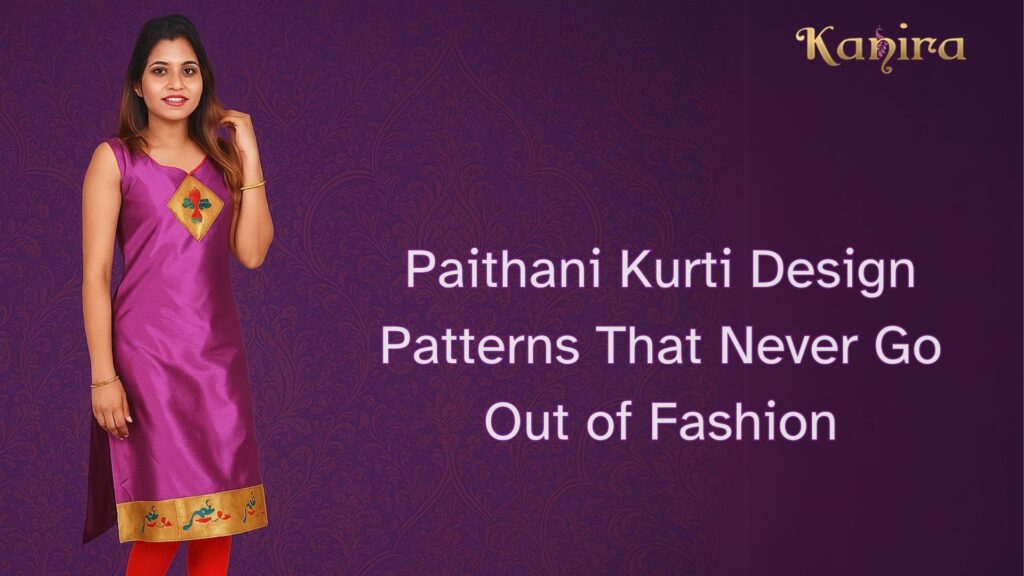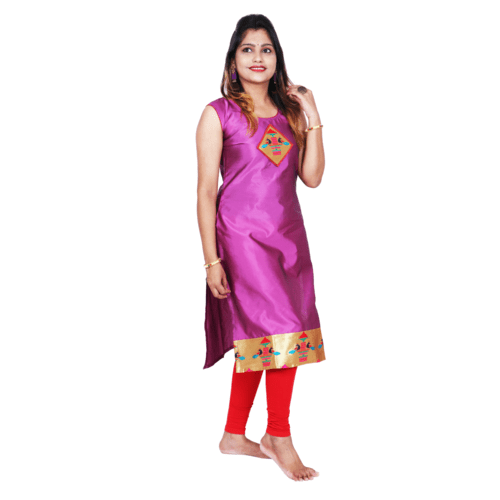
Fashion trends are fleeting — what’s in today may be forgotten tomorrow. Yet, in the sea of ever-evolving styles, some design elements defy time. One such treasure is the Paithani craft of Maharashtra, which continues to reign in the ethnic wear space with unmatched grace and relevance. Over centuries, Paithani has evolved from being the pride of royal sarees to being reimagined into contemporary staples like Paithani Kurtis. These kurtis offer the elegance of handwoven art with the comfort of modern silhouettes — a perfect blend of old-world charm and current-day functionality.
Paithani Kurtis are not just garments; they are living expressions of Maharashtra’s rich handloom heritage. The traditional motifs woven in lustrous zari — such as peacocks, parrots, lotuses, and geometrical shapes — are not mere decorations. They tell stories of nature, spirituality, and legacy. These timeless design patterns, when translated into kurtis, make for versatile pieces that can be worn across generations without ever appearing dated.
In this blog, we’ll dive into some of the most beloved Paithani Kurti design patterns that have stood the test of time, showcasing how you can incorporate them into your everyday style and festive wardrobe alike.
Paithani weaving is a handloom tradition that dates back over 2000 years, tracing its roots to the Satavahana dynasty. Originally woven for royal families, the fabric was often considered a symbol of aristocracy and grace. What makes Paithani stand apart is the use of intricate zari work, pure silk threads, and handwoven motifs that reflect themes of spirituality, harmony, and nature.
When these weaves are adapted into kurtis, they bring with them the prestige of tradition and the practicality of everyday wear. The meticulous motifs — from the iconic peacock to the sacred lotus and symmetrical diamonds — are preserved in their original form, offering wearers a slice of history. Each kurti thus becomes more than a piece of clothing; it becomes a canvas of storytelling and artistry.
Another reason why Paithani Kurti patterns never go out of style is that they adapt beautifully to today’s demand for comfort and versatility. These kurtis are designed keeping the modern woman in mind — someone who juggles work, family, and social life. The breathable silk or cotton-blend fabric allows for all-day wear, while the traditional embellishments add a regal touch, ensuring that you never have to choose between comfort and cultural richness.
Whether worn at the office, a festive gathering, or a temple visit, a Paithani Kurti makes a dignified statement without demanding extra effort. Its blend of heritage and wearability is what makes these patterns eternally fashionable.

The Kanira Baani Maroon Paithani Kurti is a timeless masterpiece that exemplifies classic elegance. The maroon fabric is deeply rooted in Indian tradition, symbolizing strength, confidence, and sacredness. Woven with meticulous zari detailing, the peacock motif gracing the border adds an artistic flair that brings the entire kurti to life.
This kurti is ideal for women who want to blend subtlety with sophistication. It’s particularly well-suited for office settings, cultural events, or small poojas, where you want to carry a graceful ethnic vibe without appearing overdressed. Style it with beige or gold-tone palazzos and traditional kolhapuri sandals, and you’re ready to make an effortlessly majestic impression.

The Diamond Red Paithani Kurti pays homage to one of the most ancient and cherished motifs in Indian textiles — the diamond buti. In traditional Paithani, the diamond symbolizes durability, balance, and spiritual energy. Combined with the rich red hue — a color that signifies energy, passion, and festivity — this kurti becomes a powerful sartorial statement.
The fabric drapes elegantly, while the peacock Paithani border adds a layer of grandeur. This kurti works beautifully for events like Navratri, Diwali parties, or even corporate ethnic days. Pair it with golden churidars or ivory leggings and complete the look with temple jewelry for a timeless ethnic ensemble.

Gray may be an unconventional color in ethnic wear, but in the Kanira Enaira Paithani Kurti, it becomes a statement of refined elegance. The muted gray backdrop creates a sophisticated canvas for the vibrant Paithani peacock border to shine, offering a soft yet striking contrast. The subdued color makes it perfect for office wear, casual ethnic days, and understated occasions.
This kurti is a perfect example of how minimalism and tradition can coexist beautifully. Its versatility makes it a favorite among women who prefer elegance over extravagance. Pair it with soft white pants and pearl studs to let the kurti take center stage in your outfit.

Black is a color that never fails to make an impact, and the Garima Paithani Kurti is no exception. The deep black tone sets the stage for the rich gold and multicolored Paithani border to dazzle. Featuring the ever-regal peacock motif, this kurti is both festive and formal — allowing you to transition from a day event to an evening function effortlessly.
This kurti is perfect for dinner parties, family get-togethers, and even wedding sangeet ceremonies when paired with a vibrant dupatta. Complete the look with antique gold bangles, a bold ring, and embroidered juttis for a head-turning traditional outfit.
Every motif found in Paithani weaves has been thoughtfully chosen over generations. Peacocks symbolize beauty and pride, while geometric designs like diamonds stand for harmony and resilience. These motifs have been worn for centuries, and their meanings continue to resonate with modern sensibilities. It is this blend of visual appeal and deeper symbolism that makes these designs enduring.
One of the key reasons these kurtis never go out of style is their ability to be worn across occasions — from boardrooms to mandaps. Their graceful aesthetic adapts beautifully to any event, making them valuable staples in your ethnic wardrobe. You can style them up with heavy jewelry for festive settings or keep it sleek and minimal for workdays.
These kurtis aren’t made for just one age group. A teenager wearing the Diamond Red Kurti for her school’s ethnic day will look just as elegant as a mother wearing it for a family gathering. This generation-neutral quality gives them a timeless place in your closet.
To ensure your Paithani Kurtis retain their elegance for years:
These patterns are rooted in centuries-old motifs and weaving techniques. Their cultural depth and visual grace keep them relevant across changing fashion eras.
Yes. With their adaptable cuts and balanced design elements, they work beautifully in both formal and festive settings depending on how they’re styled.
You can pair them with oxidized jewelry, potli bags, mojaris, or even delicate pearls depending on the occasion and kurti color.
Absolutely. They are made with breathable fabric blends, making them wearable in all seasons. Choose lighter shades for summer and deeper tones for winter.
You can explore the complete curated category of Kanira’s timeless Paithani Kurtis here:
👉 All Paithani Kurtis
Also check this blog for more inspiration:
👉 Paithani Kurti Design for Women: A Must-Have in Your Wardrobe
Paithani Kurtis are not passing fads — they are timeless representations of India’s textile legacy. Every pattern, every zari thread, and every woven motif brings with it the soul of heritage and the touch of modern grace. Whether you prefer classic black, royal maroon, understated gray, or festive red, these kurtis will always find a place in your wardrobe, not just as fashion, but as tradition woven with love. When you wear one, you’re not just embracing style — you’re wearing a story that never goes out of fashion.
Kanira Paithani is an online store dedicated to all your love toward Paithani (Handloom from Maharashtra).



©Kanira. All rights reserved. 2025. Designed By Bufferchime